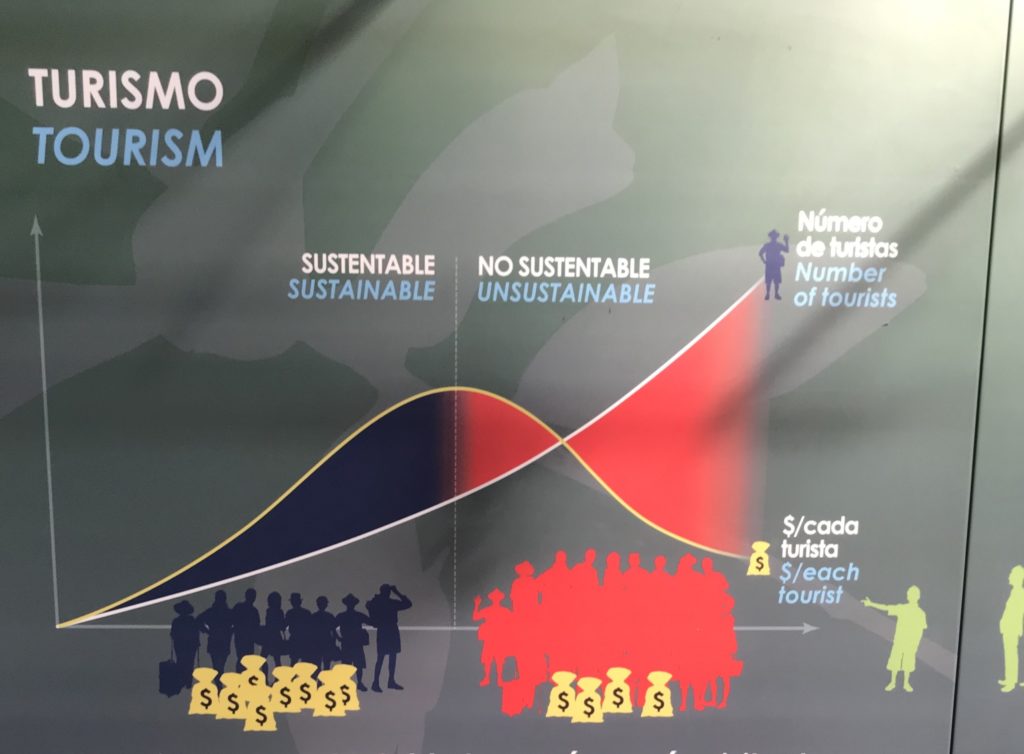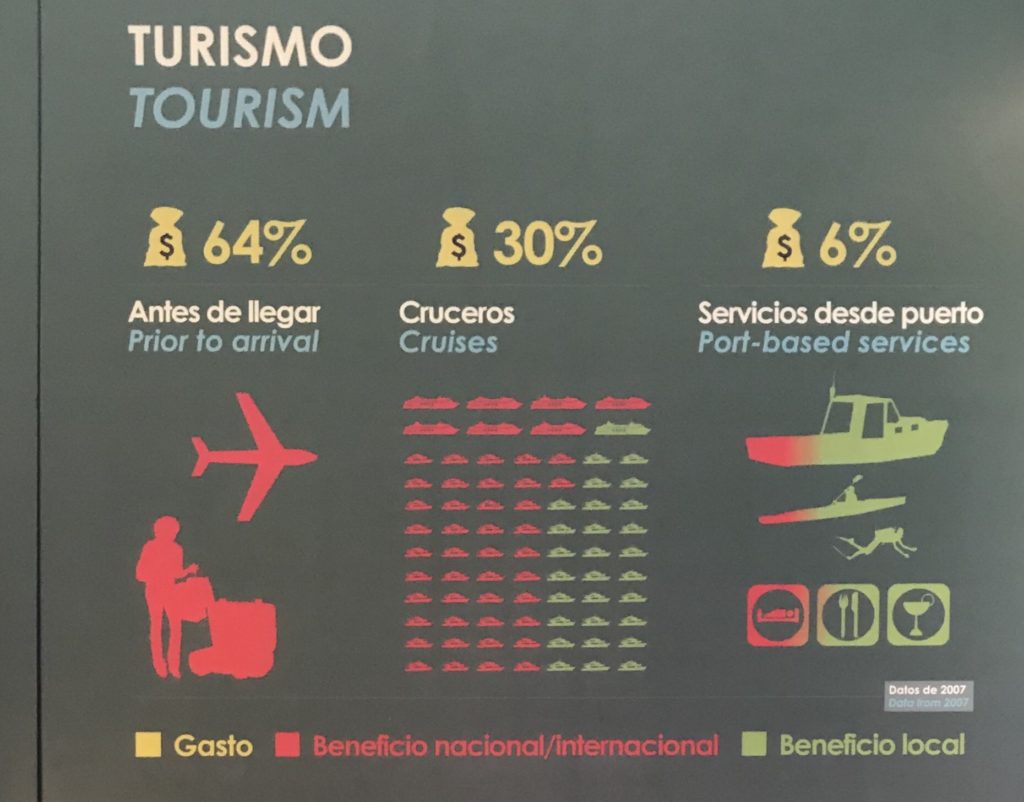Even though I have only been in the Galapagos a little over a week, the beauty and abundance of life here is astounding. The sheer number of animals here is like nothing I have seen anywhere else. Just waking up in the morning on our anchorage you can look out and see multiple turtles, sea lions, and birds without trying. However, due to these reasons it is becoming an increasingly popular spot to visit, which may not be all good.
The Ecuadorian government has regulated many aspects of living here in order to protect the environment. When I asked our taxi driver about this, he said It is very hard to get build anything new and you have to get all kinds of permits. You have to have a reason that you submit to the government in order to even be allowed to get a car. They have also totally stopped giving out boating licenses making it impossible to make the number of boats around the island bigger. Most of these changes were made in response to the population growth of people living here year round and not on mainland Ecuador. While some of the locals are not all happy with these regulations, even more think that more should be done.
One of our guides, Karla, was born on the island as well as her parents and grandparents. She had a lot of information and ideas on this topic of population. She said that she had noticed big changes in the Galapagos, along the lines of how many people are visiting here as well. She told us that back in the beginning of the tourism industry, around the 1960’s there were only half a dozen vessels and hotels catered to 2,000 guests per year. By 2006 there were 80 vessels and 65 hotels catering to 3,500 guests per night. Despite these increases, the user fees paid both by visitors and companies conducting tours have not increased since 1993.
When we visited the Interpretation Center on San Cristobal they explained that unsustainable tourism brings in more and more visitors while the value per visitor falls. The result is mass tourism, which is bad for the environment and local business. This is a picture I took from the Interpretation Center illustrating this concept.

Although it may seem like growth on the island is a good thing, one of the many problems is that the revenue from tourism is not going to the locals. Profits from tourism should benefit the local population, caring for the Galapagos’ natural assets, and properly training people to manage them.
This graph also from the Interpretation Center, shows that only 6% of tourist’s expenditures go to port based services while 64% of tourist’s expenditures is spent before they even get to the Galapagos.

Some of the other problems Karla mentioned that come along with unsustainable population growth are socioeconomic stratification, strained public services, an increase in the number of invasive species, and a number of conflicts with conservation goals and authorities. It was also reported that there is a marked decline from 1991 to 2006 on how the visitors rated their satisfaction with the Galapagos’ nature and wildlife (this was the most recent statistic I could find, but if this was 14 years ago imagine now). This is mainly from how more people are coming to the island, leading it being more crowded, which leads to less animals and not as pristine nature.
One of the solutions that some of the people I have talked mentioned is to increase the price of coming to the Galapagos. By doing this there would be not as many people, but the Galapagos is still creating revenue, and the tourists who do come get more out of their visit.
This is slightly alarming, at least to me, because it was already very expensive for us to come here on a boat in the first place. Although I am slightly biased, being on a boat already, I think that that idea could be refined a little bit. My idea is that they increase the cost of coming to the Galapagos by plane and decrease the cost of coming by boat. I have come to this conclusion because it is the expenditure from the tourists flying in that is not going to the local people, or benefiting the Galapagos Islands, and instead going to international airlines and companies.
However, the private boats that are coming to the islands are the ones supporting the local and port based business. They are eating at all the local restaurants, supermarkets, laundry services, maintenance services, water taxis, and tours, because they are not going on the cruise boats or staying at hotels where all that is taken care of for them.
However, it was the sailors – the whalers, pirates, and buccaneers – who originally just took animals at will and spread invasive species to the Galapagos Islands. They did this without thinking about the long lasting consequences which are still fresh in many people’s minds. Because of this troubling history, nowadays the Galapagos officials and Ecuadorian government have made it more difficult for private boats to get here. There are many many fees, inspections, and hoops to jump through just to go into one of the ports, let alone the National Park. While some of the environmental regulations for boaters make sense, if the other fees were more reasonable many more boats would come here on their way across the Pacific. Geographically, it makes sense to come to the Galapagos Islands as a stop to shave 840 miles from an already very long passage to the Marquesas from Panama. However, many boats we met don’t bother because of how expensive and difficult they make it to come here.
If the Galapagos Islands were to invest in boaters coming here it would greatly help the local economy. Take the city of Las Palmas in the Canary Islands for example. Almost all of the boats sailing across the Atlantic stop there to get supplies and prepare for such a long passage. Las Palmas has built an industry around servicing the boats and makes it easy for boaters to get their supplies and prepare. In return, the boaters spend money on those services along with other local expenses like touring the Islands. If the Galapagos were to be a little more welcoming to boats, more would come to the Island, which would directly help the locals, their business, and the ports.
Some of things the Galapagos could easily do to be more welcoming to boats is providing moorings in some of the ports, which is very easy to do. Providing a fuel dock to make it easier for the boats to refuel – instead of carrying the diesel to our boat by water taxi, and then pouring it in (which causes more spillage). Lastly, by having the Galapagos be more accessible to boats, there would be more consistent and manageable tourism. Not the type that becomes crazy hectic over school breaks and the summer.
Overall, many of the Galapagos’ ideas on conservation are at the forefront of environmental change and an example to other countries. However, by managing things like population and tourism, they would make that change last longer and be more meaningful in the long run.


Thoughtful analysis. A pleasure to read.
Great essay. Thank you. Enjoy your travels!
Great essay, Vera. Lots of good information about the islands that I thought I knew but now I really know.
Thanks
Loved your essay! Very informative and well written.
Very interesting, Ben!